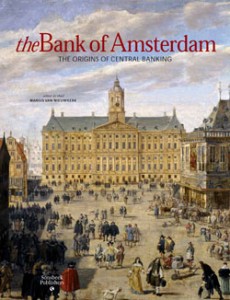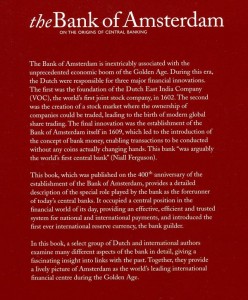 |
____ |
The Bank of AmsterdamON THE ORIGINS OF CENTRAL BANKING The bank of Amsterdam is inextricably associated with the unprecedented economic boom of the Golden Age. During this era, the Dutch where responsible for three major financial innovations. The first was the foundation of the Dutch East India Company (VOC),
the world’s first joint stock company, in 1602. The second was the creation of a stock market where the ownership of companies could be traded, leading to the birth of modern global share trading.The final innovation was the establishment of the Bank of Amsterdam itself in 1609, which led to the introduction of the concept of bank money, enabling transactions to be conducted without any coins actual changing hands, This bank “was arguably the world’s first central bank” (Niall Ferguson).
|
|
This book was published on the 400th anniversary of the establishment of the Bank of Amsterdam, provides a detailed description of the special role played by the bank as the forerunner of today’s central banks. It occupied a central position in the financial world of its day, providing an effective, efficient and trusted system for national and international payments, and introduced the first ever international reserve currency, the bank guilder.
In this book, a select group of dutch and international authors examine many different aspects of the bank in detail, giving a fascinating insight into links with the past. Together, they provide a lively picture of Amsterdam as the world’s, leading international financial center during the golden age.
|
||
Uitgeverij: Sonsbeek |
 |
|
